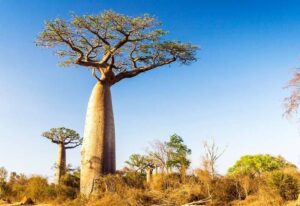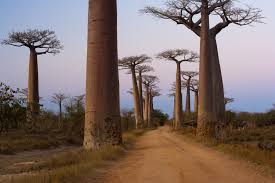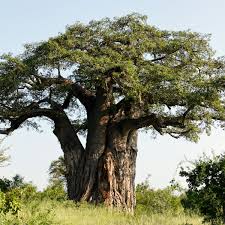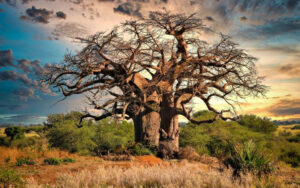The baobab tree, often referred to as the “Tree of Life,” is among the oldest living organisms on Earth. Native to the African continent, these trees have stood the test of time, some living for over 2,000 years. With their massive trunks, iconic upside-down appearance, and countless ecological benefits, baobabs are an essential part of Africa’s landscape and culture. They have adapted to harsh environments and play a crucial role in supporting local biodiversity and communities.

What Makes the Baobab Tree Unique?
The baobab tree (Adansonia species) is unlike any other tree in the world. Here are some remarkable characteristics that make it stand out:
- Longevity: Many baobab trees have been dated to be well over 2,000 years old, with some estimated to be closer to 3,000 years.
- Distinct Appearance: The baobab’s thick, swollen trunk stores water, giving it a bottle-like or upside-down appearance.
- Gigantic Size: The trunks can reach up to 14 meters (46 feet) in diameter and can store thousands of liters of water.
- Deciduous Nature: The tree sheds its leaves during the dry season, conserving water in its massive trunk.
- Unique Flowers: The baobab produces large, white flowers that bloom at night and are pollinated by bats.
- Edible Fruits: The tree bears nutrient-rich fruits, commonly called “monkey bread”, which are packed with vitamin C, calcium, and antioxidants.
- Adaptability: Baobabs thrive in arid conditions with little rainfall, relying on their ability to store water and shed leaves to reduce moisture loss.
The Oldest Baobab Trees in Africa
Several baobabs across Africa have been carbon-dated to be among the oldest living trees on the planet. Some notable specimens include:
1. The Panke Baobab (Zimbabwe)
Once estimated to be over 2,500 years old, the Panke Baobab was sadly destroyed in 2011 due to natural causes.
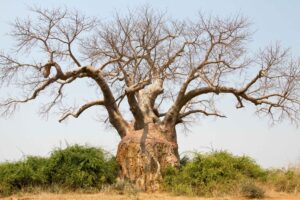
2. The Sunland Baobab (South Africa)
This famous baobab, with an estimated age of 1,000+ years, was renowned for housing a pub inside its massive trunk. Unfortunately, the tree partially collapsed in 2017.

3. Chapman’s Baobab (Botswana)
Once used as a landmark by 19th-century explorers, this ancient tree was estimated to be over 1,400 years old before it fell in 2016.

4. The Grootboom Baobab (Namibia)
Carbon dating suggests this baobab was at least 1,275 years old before it collapsed in 2004.
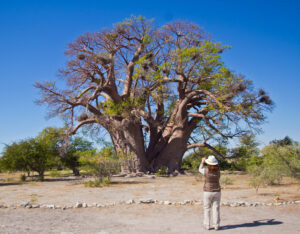
Why Do Baobab Trees Live So Long?
The incredible lifespan of baobab trees can be attributed to several factors:
- Water Storage Ability: Baobabs can store thousands of liters of water within their trunks, allowing them to survive in extreme drought conditions.
- Regenerative Growth: Unlike most trees, baobabs can hollow out and still continue to live, regrowing from the remaining bark.
- Fire and Disease Resistance: Their thick bark is fire-resistant, and they are naturally resistant to most pests and diseases.
- Genetic Adaptation: The DNA of baobab trees has evolved to help them thrive in harsh environments.
- Slow Growth Rate: Unlike fast-growing species, baobabs have an incredibly slow growth rate, which contributes to their longevity.
The Cultural and Spiritual Significance of Baobabs
Baobabs hold deep cultural and spiritual significance in African traditions. They are often referred to as “sacred trees” and are used for various purposes:
- Medicinal Uses: The bark, leaves, and fruits are used in traditional medicine to treat ailments such as fevers, digestive issues, and infections.
- Community Gatherings: Many African communities use large baobabs as meeting places, shrines, or even as homes.
- Myths and Legends: Some African legends say the baobab was planted upside-down by the gods, explaining its unique shape.
- Symbol of Strength: In many cultures, baobabs represent wisdom, resilience, and endurance.
Ecological Importance of Baobabs
Baobabs are crucial to the ecosystems they inhabit. Their presence benefits the surrounding environment in multiple ways:
- Water Source: Animals and humans rely on stored water in the tree’s trunk during droughts.
- Habitat for Wildlife: Baobabs provide shelter and food for a variety of species, including bats, birds, elephants, and monkeys.
- Pollination Role: Their flowers rely on nocturnal pollinators such as bats and moths to ensure reproduction.
- Carbon Sequestration: These ancient trees play a significant role in absorbing carbon dioxide, helping to combat climate change.
Threats to Baobab Trees
Despite their resilience, baobabs are now facing serious threats:
- Climate Change: Rising temperatures and changing rainfall patterns are impacting their growth and survival.
- Deforestation: Land clearance for agriculture and urban development is reducing baobab populations.
- Mysterious Deaths: Scientists have recently discovered that some of the oldest baobabs are dying suddenly, possibly due to environmental stress.
- Overharvesting: The increasing demand for baobab fruit and bark for commercial use threatens its sustainability.
Conservation Efforts to Protect Baobabs
To ensure these ancient giants survive for future generations, various conservation initiatives are underway:
- Reforestation Programs: Organizations are planting new baobab trees to replenish declining populations.
- Protected Areas: Some baobabs are now located in national parks and reserves.
- Scientific Research: Ongoing studies aim to understand the reasons behind the mysterious deaths of ancient baobabs.
- Sustainable Harvesting: Efforts are being made to promote ethical and sustainable use of baobab products.
Final Thoughts
The baobab tree stands as one of the oldest and most fascinating living things on Earth. Its remarkable ability to store water, provide food, and support ecosystems makes it an indispensable part of Africa’s heritage. However, the growing threats of climate change and human activity put these magnificent trees at risk. Conservation efforts are essential to ensure that future generations can marvel at these ancient giants for centuries to come.
